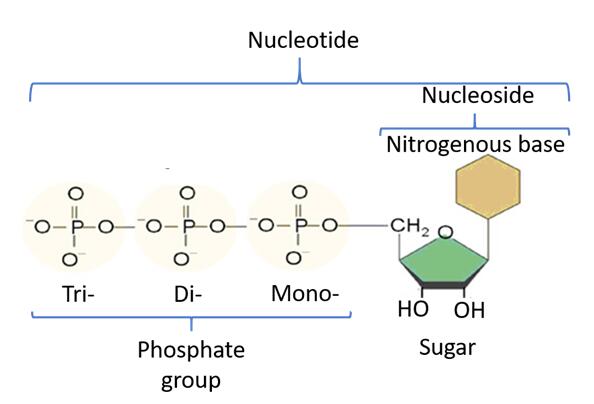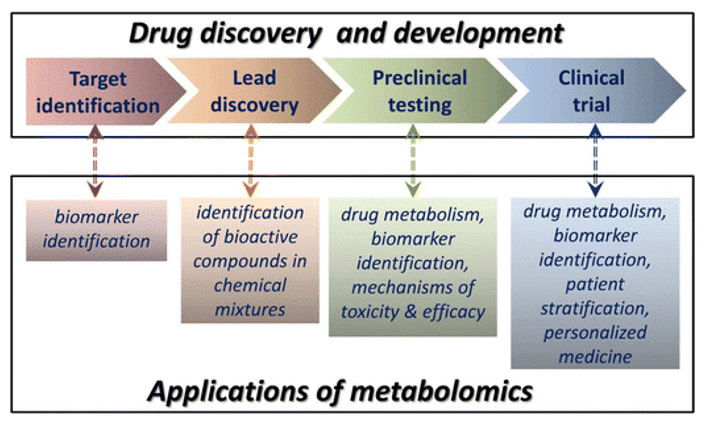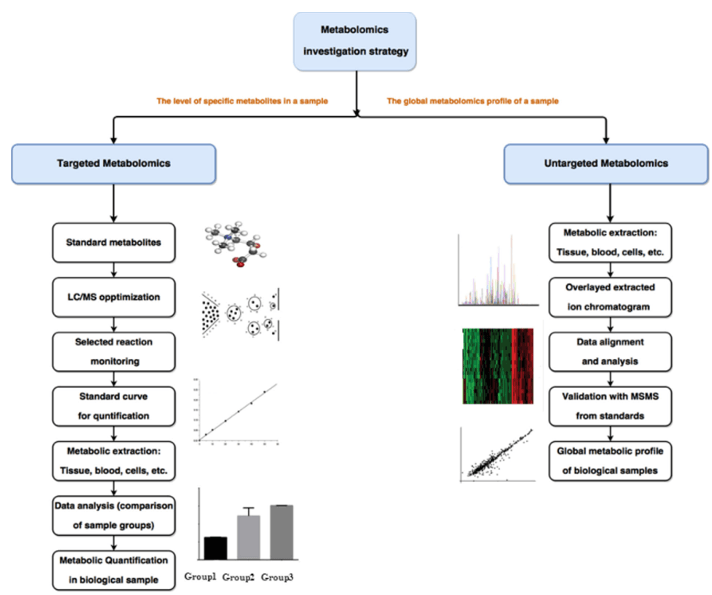Overview
The nucleotide, a building component of DNA and RNA, is made up of three parts: a nitrogenous base, a 5-carbon sugar, and a phosphate group (Figure 1). Nitrogenous bases contain purine or pyrimidine base. DNA contains adenine (A), guanine (G), thymine (T) and cytosine (C), whereas RNA contains adenine, guanine, uracil (U) and cytosine. A nucleotide contains a pentose sugar. DNA (Deoxyribonucleic acid) contains deoxyribose sugar and RNA contains a ribose sugar. Phosphate group is attached to the sugar of nucleoside by an ester bond with the 5th C hydroxyl group. Nucleotides at least contain one phosphate group. Besides being the basic unit of genetic material for creatures, a nucleotide can have other functions as well. For example, they are also found in coenzymes like NAD and NADP, which come from ADP; these molecules are used in many chemical reactions that play roles in metabolism. Another molecule that contains a nucleotide is cyclic AMP, a messenger molecule that is important in many processes including the regulation of metabolism and transporting chemical signals to cells. Nucleotides not only make up the building blocks of life, but also generate many different molecules. Therefore, its aberrant is closely associated with human pathologies like anaemia and cancer. Scientists at Creative Proteomics take advantage of highly quantitative methods with high-performance liquid chromatography (HPLC) for the determination of nucleotides in various samples. Furthermore, we provide reliable, rapid and cost-effective nucleotides related service to speed up your research aims ranging from diseases diagnosis to gaining new insights in disease mechanism or treatment.
 Figure 1. The basic structure of nucleotides
Figure 1. The basic structure of nucleotides
The Main Applications of Nucleotide Metabolism Service
- Identifying novel biomarkers of diseases
- Improving diagnose diseases
- Accelerating development of novel drugs
- Gaining new mechanism of diseases
Advantages of Our Nucleotide Metabolism Service
- Constantly optimized protocol and analytical software
- Professional experiment design
- Quick turnaround time
- High accuracy, specificity, and sensitivity
Service Workflow
Creative Proteomics provides nucleotide metabolism analysis service in a reliable and effective manner, based on our cutting-edge HPLC-MS platforms. The experimental procedures contain four main procedures: sample collection, metabolites extraction, HPLC-MS data analysis and bioinformatics analysis (Figure 2). Our service will be tailored to specific samples and needs for optimal results.
 Figure 2. The overall workflow of nucleotide metabolism
Figure 2. The overall workflow of nucleotide metabolism
List of Partial Detectable Nucleotide Metabolism Related Metabolites at Creative Proteomics
Sample Requirements
We can analyze a wide range of biological materials including but not limited to cells and solid tissues from animals. If you need transport your samples to us, please follow the following requirements for different types of sample:
- Blood/plasma: 500ul/sample
- Urine: 1ml/sample
- Tissue: 200mg/sample
- Cells: 1x107/sample
- Feces: 500mg/sample
Shipment condition: dry ice
Report Delivery
- Experimental protocols
- Instrumental factors of HPLC
- The raw data files of HPLC and the summary of HPLC data quality
- Bioinformatics analysis report
Based on advanced HPLC platforms for the determination of nucleotide metabolism, professional bioinformatic analysis software and experienced technicians and scientists, Creative Proteomics provides customer-tailored nucleotide metabolism analysis service with rapid experimental procedures and easy to read report, to accelerate your scientific research.
References
- Roy B, Depaix A, Périgaud C, et al. Recent Trends in Nucleotide Synthesis. Chem. Rev. 2016. 116:7854– 7897.
- Lachant N A, Zerez C R, Barredo J, et al. Hereditary erythrocyte adenylate kinase deficiency: a defect of multiple phosphotransferases? Blood. 1991. 77:2774-2784.
For Research Use Only. Not for use in diagnostic procedures.


 Figure 1. The basic structure of nucleotides
Figure 1. The basic structure of nucleotides Figure 2. The overall workflow of nucleotide metabolism
Figure 2. The overall workflow of nucleotide metabolism






